 While doing these landed home series, our minds started to gravitate towards the history of Singapore, and how the premium landed estates ended up in these locations. In retrospect, those history lessons back in the day did serve us well, as British colonisation served as a guide and was a big influence in Singapore’s urban planning. This time round, we found out that Tanglin and other estates were established way back in the 1800s, having over 200 years of history on Singapore land plots, and the current standing for those locations now. It’s history comes alive! Sit tight and follow along on this rather educational journey for landed homes! Who knows? You might be still living in one of these gems!
While doing these landed home series, our minds started to gravitate towards the history of Singapore, and how the premium landed estates ended up in these locations. In retrospect, those history lessons back in the day did serve us well, as British colonisation served as a guide and was a big influence in Singapore’s urban planning. This time round, we found out that Tanglin and other estates were established way back in the 1800s, having over 200 years of history on Singapore land plots, and the current standing for those locations now. It’s history comes alive! Sit tight and follow along on this rather educational journey for landed homes! Who knows? You might be still living in one of these gems!Setting up the foundation of landed housing through Singapore’s history
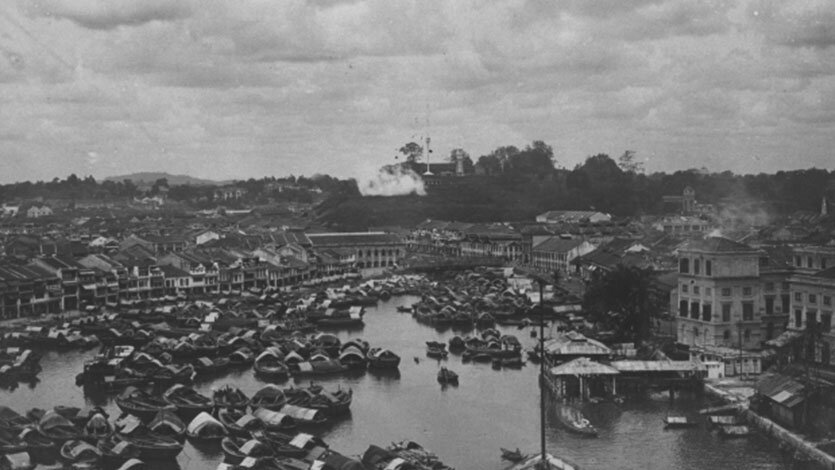
Early Singapore during British rule courtesy Visit Singapore.
It may come as a surprise to many that the history of Singapore dates all the way back to the 14th century. The island of Singapore was operating as a trading settlement due to its prime location as a port, and was ruled by Parameswara at that time, before he was attacked and forced out by either the Majapahit or the Siamese.
The colonisation of Singapore began in the 18th century, when Sir Stamford Raffles set foot onto the island in 1819. He quickly identified the strategic location of Singapore and immediately expressed interest for the British to use Singapore as a port, which will be a great trading post for them to overtake the Dutch as the dominant power in the archipelago. Sir Stamford Raffles signed the Treaty of Friendship and Alliance on 6 February 1819, representing the British East India Company (EIC) and then Singapore’s Malay rulers Sultan Hussein and Temenggong Abdul Rahman, essentially granting the British EIC the exclusive right to establish a trading post on Singapore island in exchange for monetary compensation and British military protection for the Malay Rulers. This marked the birth of Singapore as a British settlement. Sir Stamford Raffles then left Major William Farquhar in charge of the new settlement with the caveat that Singapore would remain a free port. Farquhar then invited settlers to Singapore and stationed a British official on St. John’s Island to invite passing ships to stop in Singapore. This attractive free port gained global interest, especially with the opening of Chinese trade and shipping of goods to Europe through the Suez Canal (yep, the same canal that had the large container ship stuck on 23 March 2021. Cue Suez Canal memes).

Treaty of Friendship and Alliance, courtesy ROOTS.
Upon his return to the state of Singapore, Sir Stamford Raffles was appalled by the upkeep of the state under the appointment of Farquhar. Sir Stamford Raffles then directed Lt Phillip Jackson in 1822 to formulate Singapore’s first development plan, which focused mainly on areas along Singapore River, where the current Downtown lies. This was known as the Raffles Plan of Singapore, or The Jackson’s Plan, and it enforced a policy of ethnic segregation, which resulted in the creation of the different ethnic enclaves in Singapore.
Sir Stamford Raffles laid out several provisions for the creation of ethnic enclaves in Singapore:
-
The European ethnic quarters were to be located to the east of the cantonment, and the area of the cantonment facing the sea and the area southwest of the river between Circular Road and Telok Ayer Bay would be used for commercial and residential purposes by the European and other merchants
-
A large area south west of the Singapore River were to be reserved for the Chinese, which eventually evolved into present-day Chinatown
-
The Indians were to be settled further up the river in an area called the Chuliah Kampong. The Indians would later relocate to another area North of the river, which is the present-day Little India
-
The Bugis and the Arabs were to be located in the area next to the Sultan’s ground, commonly known as the Kampong Glam
-
The Malay settlers were to be located at the upper banks of the river, small bays, and inlets.
These provisions were incorporated into the Jackson’s Plan, but not all were implemented. By the 1827, the Chinese became the largest ethnicity in Singapore, with the Peranakans being a close second. The Peranakans played the middleman role for the British, mainly because of their trilingual competence in English, Bahasa, and Mandarin. (Interestingly enough, the Peranakans came to be due to China forbidding women to leave the country, and the Chinese male traders having wives from the Malay Peninsula hence its diverse nature).
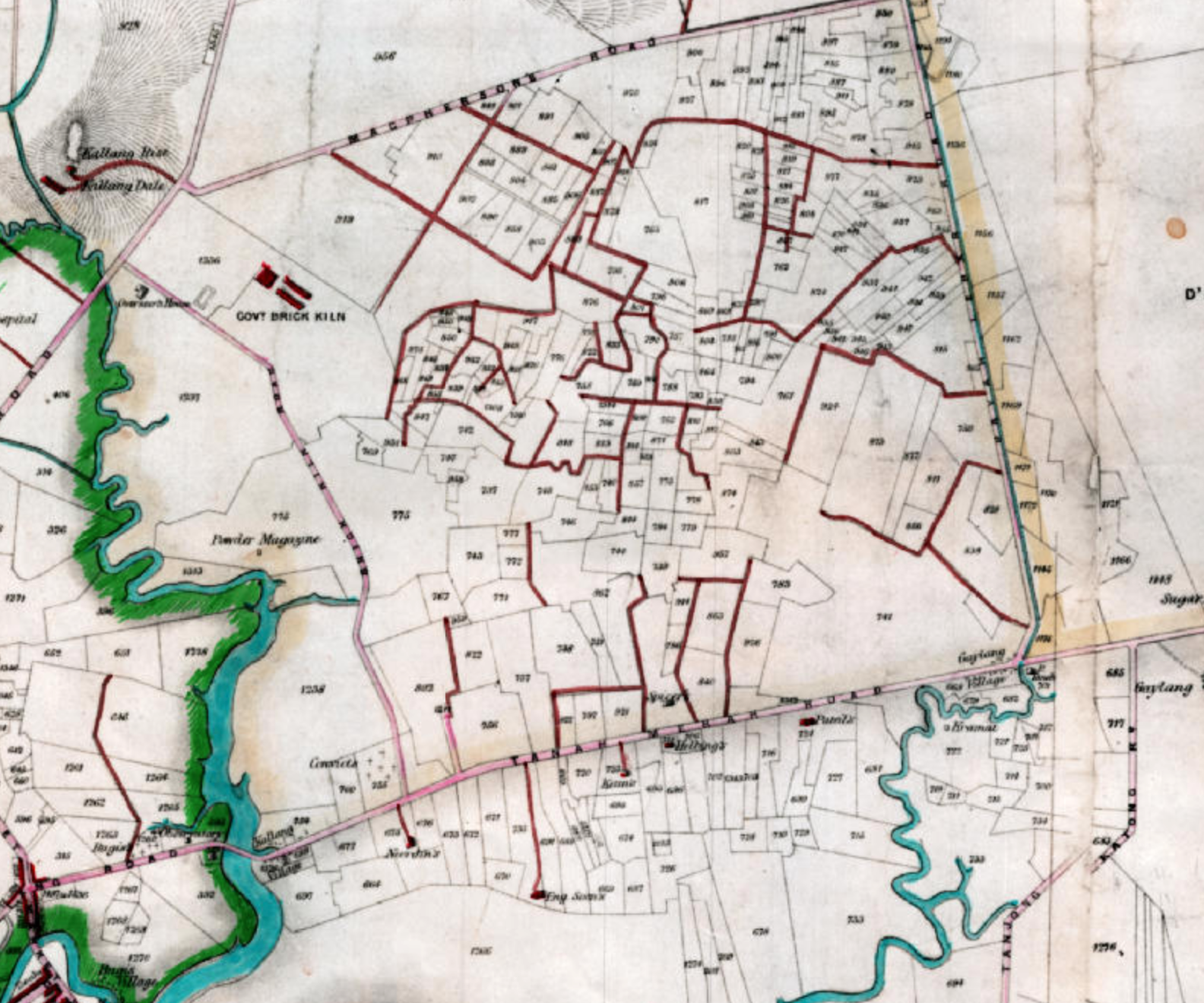
ca 1860 Geylang courtesy NUS Libraries.
The remnants and effects of the general layout proposed by the Jackson’s Plan is still observable in the ethnic neighbourhoods to this day.
Throughout the 18th and 19th century, the Peranakans established their business skills by aiding trade in spices, and mining tin and rubber with Britain’s East India Company. Some even owned plantations and became rather wealthy, forming the tasteful Peranakan designs in houses that still stands today in Emerald Hill, Joo Chiat and other prominent areas.
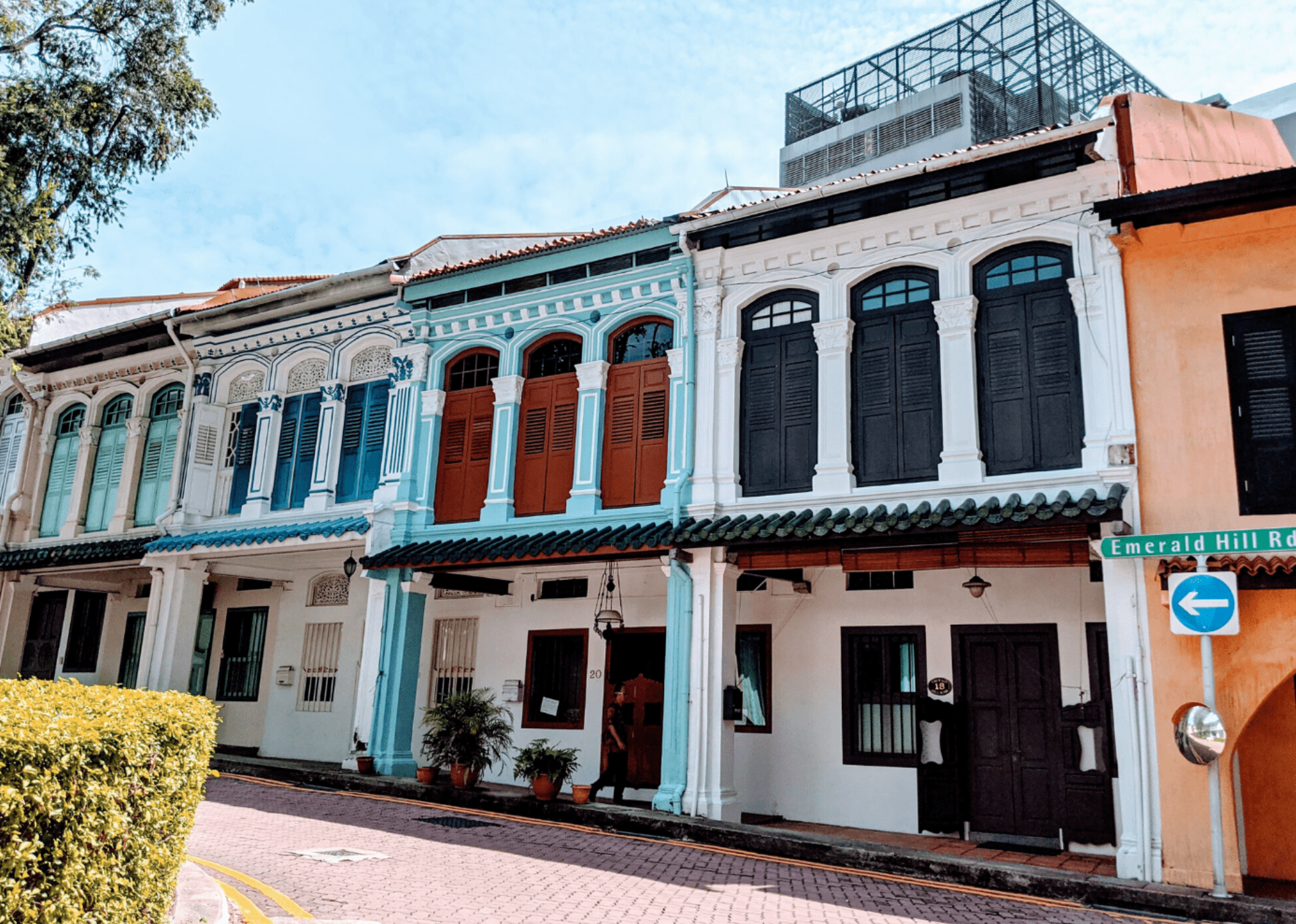
Peranakan Houses in Emerald Hill courtesy Honeycombers, Amelia Ang.
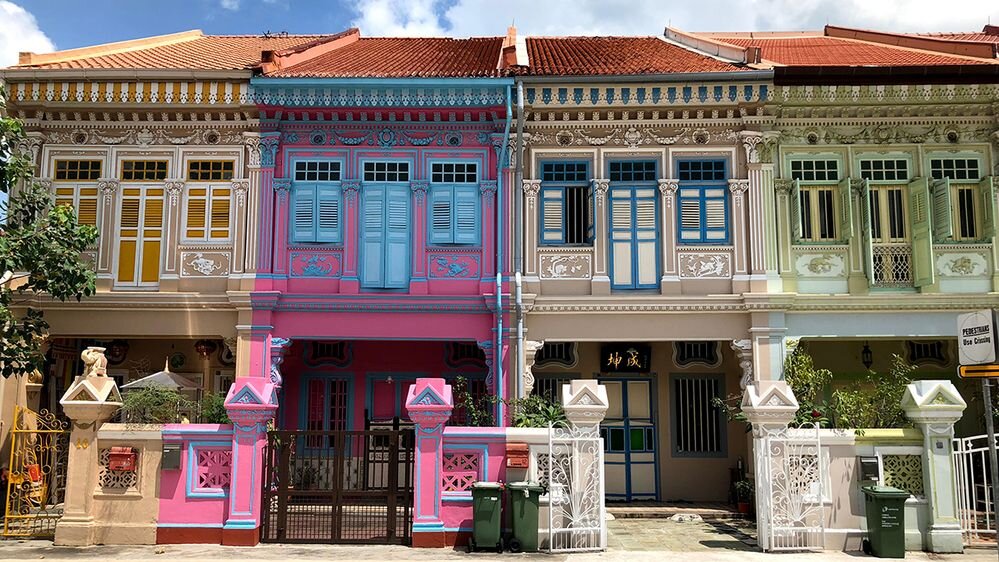
Peranakan Houses in Joo Chiat courtesy Local Guide Kenny Y.
Also, after the provision for Chinese ethnic enclaves made by Sir Stamford Raffles in the Jackson’s Plan, many Chinese, mainly the Teochews, ventured out of Chinatown and colonised the tiger-infested Tanglin area, growing various crops like sireh, pepper, nutmeg and gambier (familiar with our previous Gambier Court video?). Soon after, the Europeans, mainly Scotsmen, followed suit and started their spice plantations, and built bungalows and villas on the various hills. The influence of Scottish presence possibly gave rise to the Scottish personal and place names in the Tanglin area, such as Balmoral, Edinburgh, Claymore, and Scotts Road. It is possibly also the reason why the Tanglin district houses many affluent Singaporeans and expatriates in private properties such as bungalows and high-rise condominiums.
Prices of landed homes rising exponentially
Since then, the private residential land worth has gone up, as you can observe from the graph here:
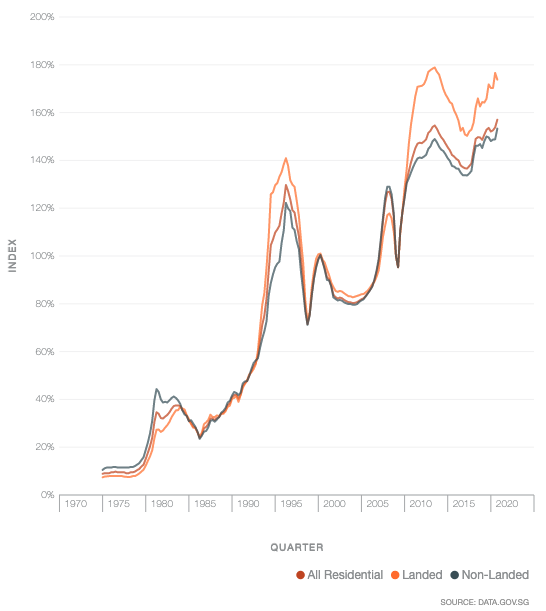
Private Property Price Index by Type, Quarterly, courtesy Data.gov.sg
The government reserved 39 areas in Singapore just for bungalows and landed housing from the period of 1975 to 1980. And since then, the prices of landed property have more than tripled. (If you are wondering how certain families are able to afford landed properties in premium housing estates, some bought them at the beginning). In the year 1974 to 1978, restrictions were placed on foreigners buying landed property and middle income HUDC flats. The construction of HUDC flats provided stiff competition for private developers, causing them to delay and hold back building plans because of low demand. This restriction induced developers to switch from building landed houses to flats, which resulted in the scarcity of landed properties. The holding back of building plans, coupled by the fact that Singapore was facing a sustained economic growth after the depressed economic period in the mid 1970s meant that there was a severe shortage of housing. The high demand in a period of severe shortage of housing led to the drastic landed housing boom in 1980 to 1981.

Singapore Economic Growth Rate 2021 courtesy Macrotrends
While the rise and fall of prices are commonly pegged to economic stability, as proven in the huge dip in 2008’s Great Recession, landed home prices skyrocketed from the mid 1980s to 1996 due to Singapore’s prosperous economy then. The private housing prices in Singapore are also highly correlated with the prices for public housing, as seen in the graph. Moreover, the timing of government policies relating to the use of CPF and compulsory savings for private housing finance, coupled with the liberalisation of rules on public housing ownership criterion as well as financing for residential properties aided in the private housing boom in the mid 1980s.
Buyers who bought landed properties at the highs after the 2nd quarter in 1996 suffered the most, and worsened with the ‘98 Asian financial crisis. As of late, the private property price index has been on an uptrend amidst a period of economic instability caused by the global pandemic. Will there be an imminent cooling measure in place to address this? PropertyLimBrothers has covered this in-depth about a possible 13th cooling measure this year, and a part 2 to follow up, so stay tuned for that!
How were prices for Landed housing like in Singapore?
Tembeling Road
Tembeling Road is located right at the heart of the Katong area, which is a popular place of interest given the many famous eateries in the vicinity. This possibly gave rise to the appreciation of landed properties in the area. In 1981, prices of 3 bedroom double-storey terrace were hovering at $300,000 to $400,000.

Tembeling Road, The Straits Times, 6 November 1981 courtesy NLB and SPH.
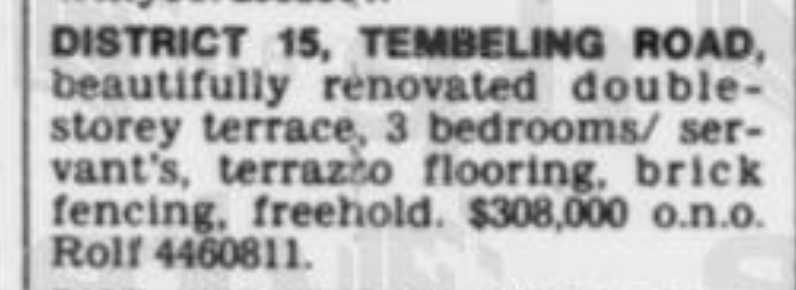
Tembeling Road, The Straits Times, 25 August 1981 courtesy NLB and SPH.

Tembeling road 4, The Straits Times, 25 August 1982, Page 29, courtesy NLB and SPH.

Tembeling road 3, The Straits Times, 31 May 1984, Page 32, courtesy NLB and SPH.
Fast forward to today, the PSF price of a landed unit at Tembeling Road has increased significantly from a little less than $1,000 PSF to around $1,200-$3,000 PSF. Historical transaction data have shown a big appreciation in transaction prices, with resale value going at around $2.9-$3.6 mil (depending on the intensity of renovations done). A landed property even went as high as $4.8 mil.
We have also done up an in-depth review of a Freehold Inter-Terrace unit for you to appreciate just why the value of a landed unit in the area have gone up by so much.
Freehold Inter-Terrace with Secret Bathroom? | Tembeling Road Home Tour | District 15 | $3.78M
Infinium, Cluster House at Richards Avenue
Infinium is a luxurious 14 units Freehold Cluster House, with asking prices of around $3.35 mil. But how did the price appreciate to this? What were the starting prices for landed properties for Richards Avenue in the Kovan area?
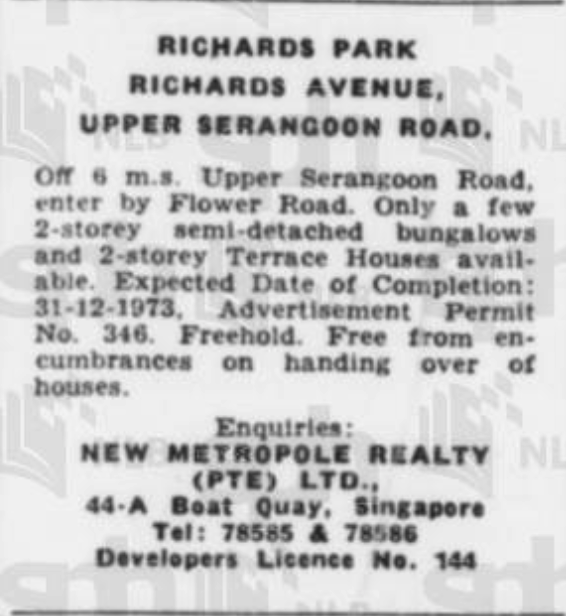
Richard’s Park back in 31 May 1973, Richard’s Avenue courtesy SPH and NLB.

Richard’s Avenue 24 Jan 83 courtesy SPH and NLB

Richard’s Avenue Historical Transactions courtesy SquareFoot.
In 1995, a freehold inter-terrace at 3,186 sq ft was sold at $1.93 mil, and thereon, it has risen to $3.75 mil for an inter-terrace just beside it for $3.75 mil in March 2021.
So is Infinium, a new cluster house along Richard’s Avenue sandwiched between a freehold inter-terrace and 99-year leasehold landed property a worthy buy? Follow us for more updates for this cluster house!
Carpmael Road

Malaya Tribune, 15 October 1936, Page 14 courtesy SPH and NLB.
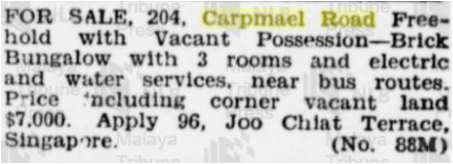
The Straits Times, 29 November 1941, Page 8 courtesy SPH and NLB.
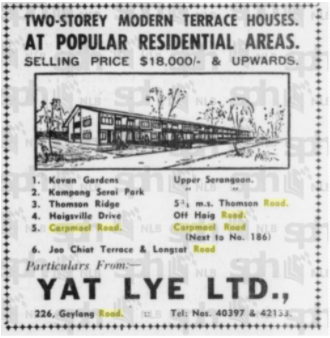
The Straits Times, 31 December 1962, Page 5 courtesy SPH and NLB.
In hindsight, it would be reasonable for one to think that landed properties in Carpmael Road in the past were dirt cheap (not taking into account inflation and time value of money). A vacant freehold Bungalow went as low as $7,000 in 1941. A two-storey terrace house was worth around $20,000 in the 1960s.

Carpmael Road historical transactions, courtesy SquareFoot.
Moving forward in time, a landed resale Terrace property was valued at around $700,000-$1.7 mil in 1995. This is a rate of return of more than 30 times. Talk about a sizeable investment return!

Carpmael Road Historical Transaction Prices courtesy SquareFoot.
Today, a landed resale Terrace property can go from anywhere between $3 mil to $5 mil. This can be seen from the healthy uptrend in historical price PSF data.
Jln Bunga Rampai

The Straits Times, 22 August 1983, Page 31 courtesy SPH and NLB.

The Straits Times, 31 October 1984, Page 33 courtesy SPH and NLB.

Jalan Bunga Rampai Historical Transaction Prices courtesy SquareFoot
Jalan Bunga Rampai is a Terrace housing enclave located in district 19 off Bartley Road. Historical prices of Terrace houses in the Jalan Bunga Rampai vicinity ranged anywhere from $400,000 to $550,000 in the 1980s, amidst the private housing boom.
The value of private Terrace houses in Jalan Bunga Rampai have almost quadrupled since, putting up its resale value of around $1.2 mil to $2.87 mil. This is likely due to convenient location, naturally appreciating its value. It is located only a stone’s throw away from Bartley MRT station and its close proximity to Upper Paya Lebar Road puts it within walking distance of various food establishments and shops along it, and is also in close proximity to various renowned schools such as Maris Stella High School and Paya Lebar Methodist Girls’ School.
Moreover, the Jalan Bunga Rampai area is slated for further residential development as it was put up for public tender under the confirmed list during the second half of the 2019 Government Land Sales (GLS) Programme. The influx of more residential development signifies a healthy demand for residential units in the area. This could potentially cause the residential market in the area to be more prosperous, allowing prices to appreciate even more.
Luxus Hills
Luxus Hills is situated in Seletar Hills Estate, district 28, located along Ang Mo Kio Ave 5 and Yio Chu Kang Road. It is a landed housing estate with a collection of semi-detached, corner-terraces and terrace houses.
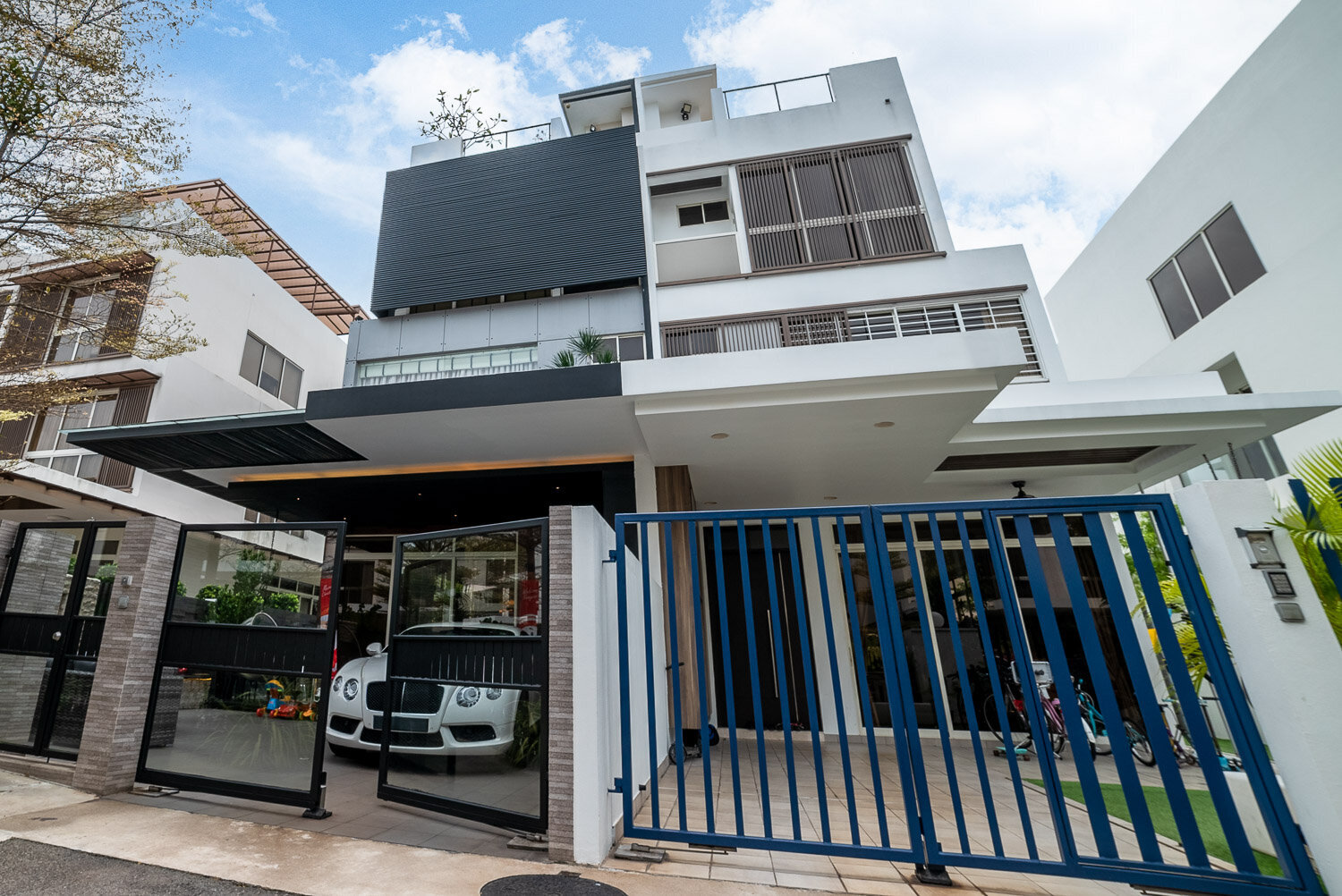
One of the homes we’ve been to at Luxus Hills.
The entire plot of land spanning Luxus Hills Avenue and Luxus Hill Drive is wholly owned and developed by Bukit Sembawang Estates Limited, and they have launched the Luxus Hills series in phases. Phases 1 to 5 have been fully sold out, and phases 6 and 7 were sold out quickly. Prices of new launch developments in the area ranged anywhere from $1.55 mil to $4 mil. So how are prices of landed properties in Luxus Hills so high, and how was it like in the past?

Luxus Hills Historical Transaction Prices courtesy SquareFoot.
Since the Luxus Hills estate is a new development, we could not obtain any data on its historical transactions. However, we can still make a comparison based on historical transactions of nearby landed housing developments, which may broaden our perspective.

The Straits Times, 14 November 1966, Page 14 courtesy SPH and NLB.

The Straits Times, 14 October 1966, Page 14 courtesy SPH and NLB.
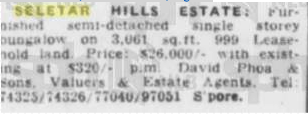
The Straits Times, 29 December 1966, Page 12 courtesy SPH and NLB.
Prices of landed semi-detached properties in the nearby landed enclave of Seletar Hill Estate fetched a valuation of around $25,000 in 1966. It is a far cry as compared to the prices of landed properties in Luxus Hills now. We have done an in-depth review of the Semi-Detached unit at Luxus Hills, do check it out!
Luxus Hills 3.5 Storey Semi-Detached Singapore Landed Property Home Tour in District 28 | $4.88M
Leith Park
Leith park is located in the Kovan landed enclave, situated in district 19. The prices of double-storey terrace houses in the Leith Park area ranged from $250,000 to $450,000 back in the early to mid-1980s.
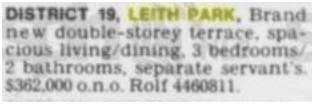
The Straits Times, 28 September 1981, Page 30 courtesy SPH and NLB.

The Straits Times, 28 September 1981, Page 30 courtesy SPH and NLB.

The Straits Times, 3 July 1985, Page 36 courtesy SPH and NLB.
Fast forward to today, prices of said terrace houses have almost 10x, with resale value going at around $1.5m to $3.3 mil. This could be attributed largely to its prime location. It boasts great connectivity and has easy accessibility to Kovan MRT station, food establishments like Chomp Chomp Food Centre and Serangoon Garden Market & Food Centre, and other facilities like Serangoon Gardens Country Club, Serangoon Stadium, and even NEX shopping mall.

Leith Park Historical Transaction Prices courtesy SquareFoot
We have done up an in-depth home tour of a semi-detached property at Leith Park, do check it out!
Leith Park Semi Detached Landed Home Tour | Singapore Landed Property | Freehold | $4.5 Million
Final Words
Taking into account factors such as inflation, limited land supply, the domestic economy and even periodic government intervention, it is only natural that the private landed housing market went through such drastic appreciation since its inception in the early years. In this week’s installment of our Landed Home Series, we took a walk down memory lane and we hope you have picked up some interesting facts and learned more about the history of landed housing in Singapore, and among other focused areas. If you’re keen to find out more about these areas, do approach PropertyLimBrothers, where we can aid you along discovering new homes and selling your beloved ones as well.









